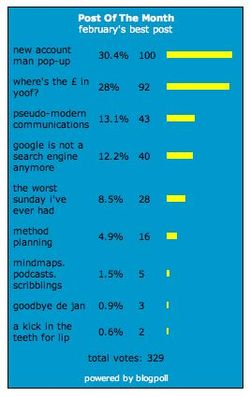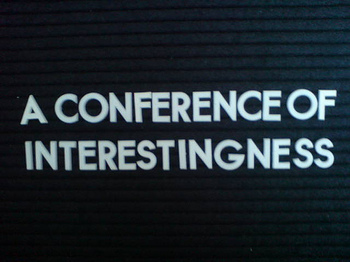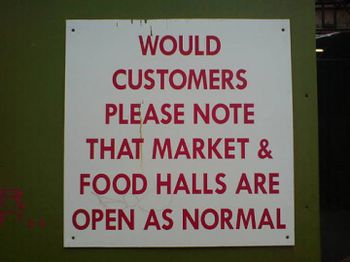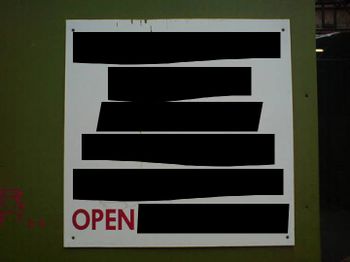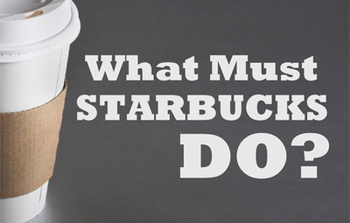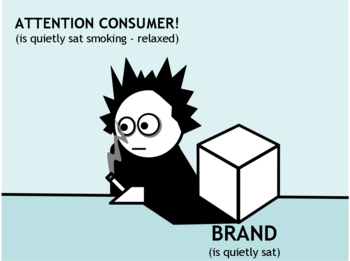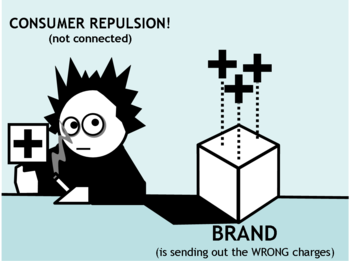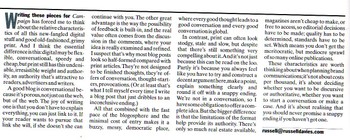
Here's last week's Campaign piece.
Writing these pieces for Campaign after
years of blogging has forced me to think about the relative
characteristics of all this new-fangled digital stuff and good
old-fashioned, grimy print. And I think the essential difference is
this; digital may be flexible, conversational, speedy and cheap, but
print still has this undeniable, irresistible weight and authority, an
authority that's attractive to readers, advertisers and writers.
A
good blog is conversational because it's porous, not just on the web,
but of the web. The joy of writing one is that you don't have to
explain everything, you can just link to it. If your reader wants to
pursue that link she will, if she doesn't she can continue with you.
The other great advantage is the way the possibility of feedback is
built-in, and the real value often comes from the discussion in the
comments, where your idea is really examined and refined. I suspect
that's why most blog posts look so half-formed compared to print
articles, they're not designed to be finished thoughts, they're offers
of conversation, thought-starters, provocations. (Or at least that's
what I tell myself every time I write a blog post that just dribbles to
an inconclusive ending.) All that combined with the fast pace of the
blogosphere and the minimal cost of entry makes it a buzzy, messy,
democratic place where every good thought leads to a good conversation
and every good conversation is global.
In contrast, print can
often look stodgy, stale and slow, but despite that there's still
something very compelling about it. And it's not just because this can
be read on the loo. Partly it's because you always feel like you have
to try and construct a decent argument here, make a point, explain
something clearly and round it off with a snappy ending. We're not in a
conversation, so I have some obligation to offer a complete idea. But
the bigger difference is that the very limitations of the format help
provide it's authority. There's only so much real estate available,
magazines aren't cheap to make, or free to access, so editorial
decisions have to be made; quality has to be determined, standards have
to be set. Which means you don't get the meritocratic but mediocre
sprawl of so many online publications.
These characteristics are
worth thinking about when planning brand communications; it's not about
costs per thousand it's about deciding whether you want to be
discursive or authoritative, whether you want to start a conversation
or make a case. And it's about realising that you should never promise
a snappy ending if you haven't got one.
Russell Davies
As disappointed as you are
About | Feed | Archive | Findings | This blog by email
« February 2007 | Main | April 2007 »
blog vs print
March 13, 2007 in campaign | Permalink | Comments (8)
february post of the month
I have a confession to make. This month's voting was supposed to finish yesterday at 10pm. But we had internet problems yesterday and I've only now been able to check the voting. So right now, the winner's New Account Man Pop-Up. But, since it's so close, it's entirely possible that the winner at the official closing time was Where's The £ in Yoof. So I think the fairest thing is to declare a draw and say you're both winners. And say you're both entitled to display this fine logo on your own site. That fair enough?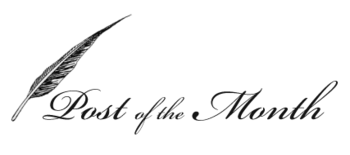
March 13, 2007 in Of The Month | Permalink | Comments (3)
a possible date for your diary
The TED conference has just finished in Monterery. Sounds like a fantastic lot of speakers. I was lucky enough to go last year and I'd put aside the money to go again this year. But, a while ago, it occurred to me that I could take that money and we could maybe organise a conference of our own here in the UK, which might be even more interesting. Or at least easier to get to.
So this is the plan:
We've booked the Conway Hall for the 16th of June. Which is a Saturday. It'll be about £20 to get in. I want to make it something almost anyone can afford.
The plan is to have all sorts of speakers speak about all sorts of stuff. Not brands, advertising, blogging and twitter but interesting, unexpected, original things. I'm hoping to find fascinating people and to just ask them to speak about something they care about. I want to replicate the experience of clicking from one really good blog to another, ranging across sciences, arts, musics, jokes and whatever. There will be 20 minute slots and 3 minute slots. Some people will play music or sing. And some people who can't be there will be asked to send three minute videos. Perhaps. I reckon we can squeeze a lot of interestingness into a day. And then have a party afterwards.
But it'll all be down to the goodwill and enthusiasm of the speakers anyway, because I won't be able to pay any of them.
The hall is paid for, seats and presentation stuff will be paid for. But that's the 'TED money' soaked up. After that I'm hoping to find sponsors to chip in, not to pay money and put up a logo but to provide things like wifi, smoothies, or cakes. And it'd be great if someone would like to film it properly, or podcast it, or do nice drawings. I don't think we'll be having name badges, branded pens or lime cordial so we won't worry about them.
I think that's about it for now. It's June the 16th. If you think you might come it'd be nice if you'd comment below, just so we can start to get a sense of numbers. And I'll soon get round to setting up paypal for tickets and upcoming and all that sort of thing. If you can think of someone we should ask to speak, that'd be great too. Or maybe you want to speak? I've already asked some people but I think they all thought I was joking so I'm going to ask again now I've written this.
And we need a name for it. I'm not sure The Conference Of Interestingness is good enough. Any suggestions?
March 12, 2007 in interesting2007 | Permalink | Comments (103)
notices
If you're only reading the RSS feeds (and who can blame you?) I should point out that there's a few interesting looking jobs in the distributed village notices section on the left hand side of m'blog. There's this job at Innocent. One at Propeller. And others at Lowe, Modernista and Dare. And I've got a few more to stick up this week. Just so you know.
March 12, 2007 in stuff | Permalink | Comments (1)
less is not as much
This sign has bothered me for a while. And today I decided to apply Scamp's marvelous Rule Of Dicketts' Finger. Seems to do the job.
March 12, 2007 in images | Permalink | Comments (0)
assignment 14 - taking on starbucks
John and Paul are hosting/conducting a fantastic conversation over at Brand Autopsy about what Starbucks should do following Howard Schultz's recent memo. You should have a look.
But given the red-in-tooth-and-claw nature of our world I thought an interesting assignment would be to think about what all the Starbucks competitors could do to take advantage of their apparent woes. So the task is this:
Pick a Starbucks competitor in your market. (If they're not in your market yet, imagine they're coming, because they probably are). Could be a big chain, could not be. Then write a 10-point action plan for how to respond to Starbucks as a competitor. I'm looking for 10 specific and doable things (and each point must be less than 30 words). You can talk about the store experience, the products, communications, anything. And don't just rip-off the stuff that John and Paul suggest Starbucks should do, I'll be looking for that. I'm going to be marking based on the quality of the idea and how persuasively it's expressed. (But no pictures please, just words.) And I'm going to try and find a suitable guest judge and an appropriate prize.
Get your entries in by March 20th. 10pm GMT. russell at russelldavies.com. thanks
March 10, 2007 in Account Planning School Of The Web | Permalink | Comments (5)
the master on story-telling
I periodically rave about This American Life on this blog. It's the best radio programme ever. And I say that despite my love for BBC Radio 4. And here's a video of him talking about story-telling. It's fantastic. And there's more here. via Presentation Zen.
The basic thought here; make sure you have both a good anecdote (sequence of events) and a good, meaningful 'moment of reflection' is perfect presentation advice.
March 07, 2007 in ideas | Permalink | Comments (5)
february nominations
Here are this month's nominations:
Paul Colman - Mindmaps. Podcasts. Scribbling.
Paul Colman - Goodbye De Jan.
Richard Huntington - A Kick In The Teeth For LIP
Amelia Torode - Google Is Not A Search Engine Anymore
Adlads - Where's the £ in yoof?
Faris Yakob - Pseudo-Modern Communications
Casper Willer - Method Planning
Diablog Cafe - New Account Man Pop-up
Paul Colman - The Worst Sunday I've Ever Had
Voting closes on Monday 12th at 10pm. Exercise your rights! Let's see if Colman can do it this time, or whether he's been spread too thin.
March 07, 2007 in Of The Month | Permalink | Comments (10)
sacrum is onto something
My only question for Sacrum, what if there are two consumers, one negatively charged, one positively charged, what should the brand do then?
March 06, 2007 in brands | Permalink | Comments (8)
